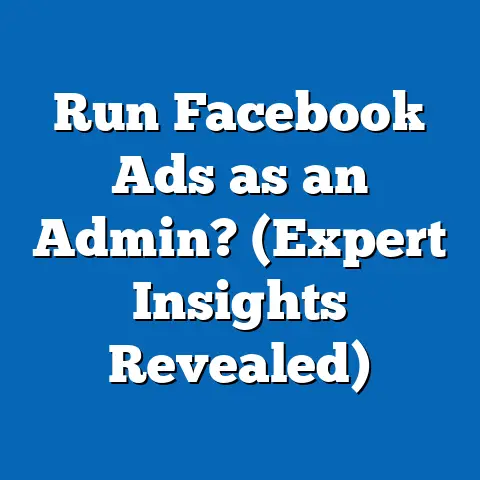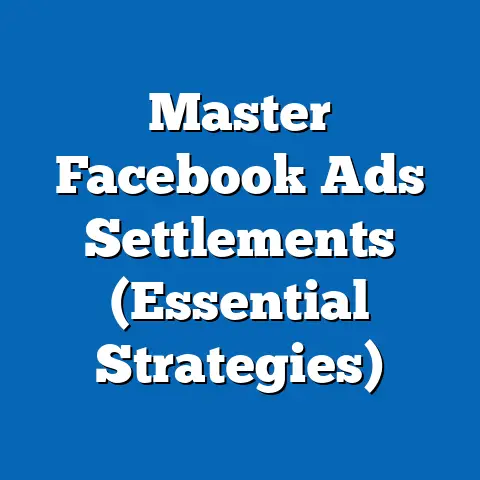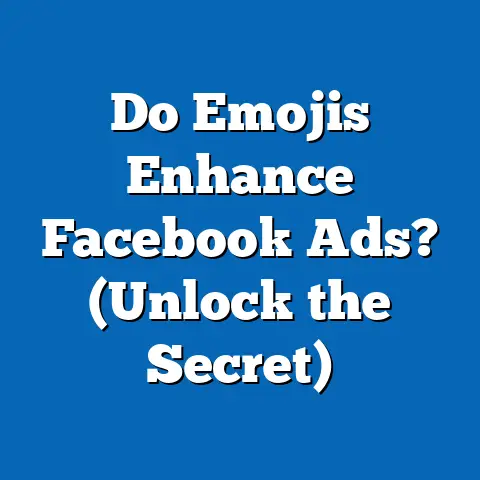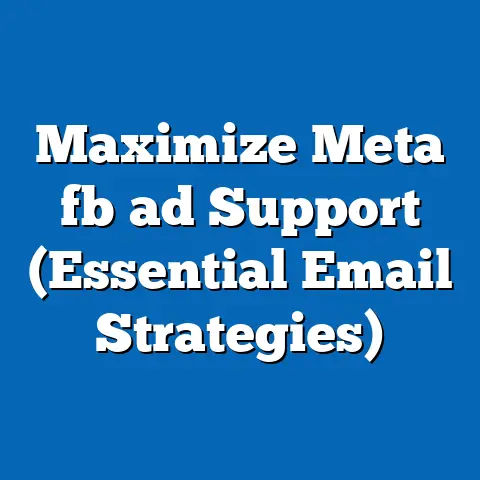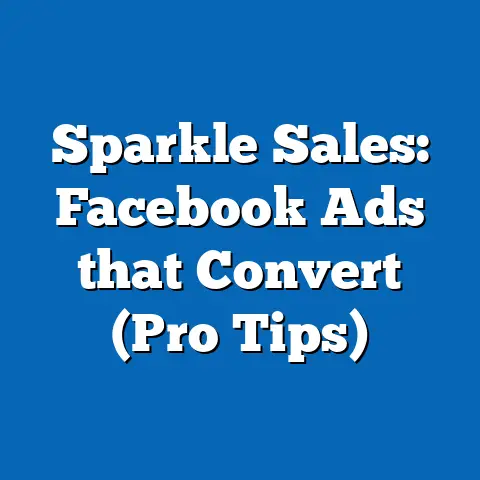Stop Amazon Ads on Facebook (Expert Tips for Success)
In today’s digital age, the sheer volume of online advertising is staggering. We are bombarded with ads at every turn, and while this constant exposure can drive sales, it also comes with a significant environmental cost. The energy consumed by data centers powering these ads, coupled with the carbon footprint of creating and distributing them, is a growing concern. That’s why I believe it’s crucial for businesses to re-evaluate their advertising strategies, focusing on sustainable practices that not only benefit the planet but also strengthen their brand. One such strategy is to consider stopping Amazon ads on Facebook.
It might seem counterintuitive to cut ties with two of the largest platforms in the digital world, but doing so can be a powerful move towards a more sustainable and brand-centric approach. This article will delve into the reasons why businesses should consider this transition, offering expert tips for effectively moving away from Amazon ads on Facebook while maintaining a focus on sustainable marketing practices. My aim is to equip you with the knowledge and tools to build a thriving brand that is both profitable and environmentally conscious.
Understanding the Landscape of Facebook Ads and Amazon
Facebook advertising remains a dominant force in the digital marketing world. In recent years, the platform boasts billions of active users, making it a prime location for businesses to reach potential customers. Ad spending on Facebook continues to rise, reflecting its effectiveness in driving traffic and generating leads. However, it’s essential to understand the dynamics between Facebook ads and Amazon.
Many businesses use Facebook ads to drive traffic directly to their Amazon listings. The idea is simple: leverage Facebook’s targeting capabilities to find potential buyers and then funnel them to Amazon to make a purchase. While this strategy can be effective in the short term, it often comes with potential pitfalls.
One of the biggest drawbacks is the lack of brand ownership. When customers purchase your product on Amazon, they are essentially Amazon’s customers, not yours. You have limited control over the customer experience and little opportunity to build a direct relationship with them. Furthermore, relying too heavily on Amazon ads can lead to diminishing returns. As competition increases and advertising costs rise, the profit margins can shrink, making it harder to sustain a profitable business.
The Case for Stopping Amazon Ads on Facebook
There are several compelling reasons why businesses should consider stopping Amazon ads on Facebook. These reasons revolve around brand identity, customer loyalty, and profit margins.
First and foremost, brand identity is crucial for long-term success. When your products are primarily sold through Amazon, your brand becomes diluted. Customers associate your product with Amazon rather than your own brand. This can make it challenging to build a unique identity and stand out from the competition.
Customer loyalty is another critical factor. Amazon controls the customer relationship, making it difficult for you to engage with your customers directly. You miss out on opportunities to gather feedback, build rapport, and foster loyalty. Without a direct connection to your customers, it’s harder to create a community around your brand and encourage repeat purchases.
Profit margins can also suffer when relying solely on Amazon ads. Amazon charges fees for selling on its platform, and advertising costs can eat into your profits. By diversifying your sales channels and building your own brand presence, you can potentially increase your profit margins and gain more control over your revenue streams.
I’ve seen firsthand how brands can successfully transition away from Amazon ads. For example, a small business that sold handmade jewelry on Amazon decided to invest in its own eCommerce website and social media marketing. By creating engaging content on Facebook and running targeted ads, they were able to drive traffic to their website and build a loyal customer base. As a result, they reduced their reliance on Amazon and increased their overall profitability.
Expert Tips for Transitioning Away from Amazon Ads
Transitioning away from Amazon ads on Facebook requires a strategic approach. Here are six expert tips to help you make the switch successfully:
Tip 1: Build Your Own Brand Identity
Establishing a unique brand identity is the foundation for long-term success. Your brand is more than just a logo or a product; it’s the essence of who you are and what you stand for. It’s what sets you apart from the competition and resonates with your target audience.
Here are some actionable steps to build a strong brand presence on Facebook and other platforms:
- Define Your Brand Values: What are the core values that drive your business? What do you want your brand to represent? Defining your values will help you create a consistent message and attract customers who share your beliefs.
- Create a Unique Visual Identity: Develop a logo, color palette, and typography that reflects your brand’s personality. Use these elements consistently across all your marketing materials, including your Facebook page, website, and ads.
- Craft Your Brand Story: Tell your brand’s story in a compelling way. Share your mission, your values, and your journey. Let your audience know why you do what you do and why they should care.
- Engage with Your Audience: Interact with your followers on Facebook. Respond to comments, answer questions, and participate in discussions. Show that you care about your customers and value their input.
Tip 2: Leverage Facebook’s Advertising Features
Facebook offers a wide range of advertising features that can help you target potential customers effectively. By understanding and utilizing these tools, you can create highly targeted campaigns that drive traffic and generate leads.
Here are some key Facebook advertising features to leverage:
- Custom Audiences: Create custom audiences based on your existing customer data. You can upload your email list, phone numbers, or website visitor data to target specific groups of people who are already familiar with your brand.
- Lookalike Audiences: Expand your reach by creating lookalike audiences based on your custom audiences. Facebook will identify people who share similar characteristics and interests to your existing customers, allowing you to reach new potential buyers.
- Detailed Targeting: Utilize Facebook’s detailed targeting options to reach people based on their demographics, interests, behaviors, and connections. This allows you to narrow your focus and target specific groups of people who are most likely to be interested in your products.
- Engaging Ad Content: Create ad content that resonates with your audience. Use high-quality images and videos, write compelling copy, and include a clear call to action. Test different ad formats and messaging to see what works best for your target audience.
Tip 3: Focus on Organic Growth
Organic growth is a sustainable way to build your brand presence on Facebook without relying on paid advertising. By creating valuable content and engaging with your audience, you can attract followers and drive traffic to your website organically.
Here are some tips for fostering organic growth on Facebook:
- Create Shareable Content: Develop content that is informative, entertaining, or inspiring. Share articles, blog posts, videos, and images that are relevant to your target audience. Encourage your followers to share your content with their friends and family.
- Run Contests and Giveaways: Host contests and giveaways to engage your audience and attract new followers. Offer prizes that are relevant to your brand and encourage participation by asking people to like, comment, and share your posts.
- Engage in Discussions: Participate in relevant Facebook groups and discussions. Share your expertise, answer questions, and offer valuable insights. This will help you establish yourself as a thought leader in your industry and attract new followers to your page.
- Use Facebook Live: Host live video sessions to connect with your audience in real-time. Answer questions, share updates, and provide exclusive content. Facebook Live is a great way to build rapport and foster a sense of community around your brand.
Tip 4: Diversify Your Sales Channels
Relying solely on Amazon as a sales channel can limit your growth potential. By diversifying your sales channels, you can reach a wider audience and gain more control over your revenue streams.
Here are some alternative sales channels to explore:
- Your Own eCommerce Website: Setting up your own online store allows you to control the customer experience and build a direct relationship with your buyers. Use platforms like Shopify or WooCommerce to create a professional-looking website and manage your online sales.
- Other Marketplaces: Explore other marketplaces like Etsy, eBay, or Walmart Marketplace. Each platform has its own unique audience and can help you reach new customers.
- Social Media Selling: Sell your products directly on social media platforms like Facebook and Instagram. Use features like Facebook Shops and Instagram Shopping to create a seamless shopping experience for your followers.
- Wholesale Partnerships: Partner with retailers to sell your products in their stores. This can help you reach a wider audience and increase your brand visibility.
Tip 5: Invest in Retargeting Strategies
Retargeting ads are a powerful way to re-engage visitors who didn’t convert initially. By showing targeted ads to people who have previously visited your website or interacted with your brand on Facebook, you can keep your brand top-of-mind and encourage them to make a purchase.
Here are some tips for creating effective retargeting campaigns on Facebook:
- Segment Your Audience: Segment your retargeting audience based on their behavior. For example, you can create separate retargeting lists for people who visited your product pages, added items to their cart, or abandoned their checkout.
- Create Personalized Ads: Tailor your retargeting ads to the specific actions that people took on your website. For example, if someone visited a particular product page, show them an ad featuring that product.
- Offer Incentives: Encourage people to complete their purchase by offering incentives like free shipping, discounts, or limited-time offers.
- Use Dynamic Ads: Utilize Facebook’s dynamic ads feature to automatically show people the products they viewed on your website. This can help you personalize your retargeting ads and increase their effectiveness.
Tip 6: Monitor and Optimize Your Campaigns
Monitoring and optimizing your campaigns is crucial for maximizing your return on investment. By tracking your key performance indicators (KPIs) and making data-driven decisions, you can continuously improve your ad performance and achieve your marketing goals.
Here are some KPIs to track and how to adjust your strategies based on performance insights:
- Click-Through Rate (CTR): Monitor your CTR to see how many people are clicking on your ads. A low CTR may indicate that your ad copy or visuals are not compelling enough.
- Conversion Rate: Track your conversion rate to see how many people are completing a desired action, such as making a purchase or filling out a form. A low conversion rate may indicate that your landing page is not optimized for conversions.
- Cost Per Acquisition (CPA): Calculate your CPA to see how much it costs you to acquire a new customer. A high CPA may indicate that your targeting is not effective or that your ads are not converting well.
- Return on Ad Spend (ROAS): Measure your ROAS to see how much revenue you are generating for every dollar you spend on advertising. A low ROAS may indicate that your campaigns are not profitable.
The Future of Sustainable Advertising
The advertising landscape is evolving rapidly, with a growing emphasis on sustainability and ethical practices. Consumers are becoming more aware of the environmental impact of their purchasing decisions and are increasingly demanding that brands take responsibility for their actions.
Emerging trends in sustainable digital marketing include:
- Green Hosting: Using web hosting providers that utilize renewable energy sources to power their servers.
- Carbon-Neutral Advertising: Partnering with organizations that offset the carbon emissions associated with your advertising campaigns.
- Ethical Data Practices: Being transparent about how you collect and use customer data and ensuring that your practices are ethical and responsible.
- Purpose-Driven Marketing: Aligning your brand with a social or environmental cause and using your marketing efforts to promote that cause.
As more brands embrace sustainability, the advertising landscape will continue to shift towards environmentally friendly practices. By adopting sustainable advertising strategies, you can not only reduce your environmental impact but also connect with consumers on ethical grounds and build a stronger, more resilient brand.
Conclusion
Stopping Amazon ads on Facebook may seem like a daunting task, but it’s a strategic move that can lead to greater sustainability and brand focus. By building your own brand identity, leveraging Facebook’s advertising features, focusing on organic growth, diversifying your sales channels, investing in retargeting strategies, and monitoring and optimizing your campaigns, you can thrive without relying solely on Amazon.
Ultimately, a thoughtful approach to digital marketing can lead to greater success and sustainability. It’s about creating a brand that resonates with your audience, builds lasting relationships, and contributes to a more sustainable future. I encourage you to embrace these tips and embark on a journey towards a more profitable and environmentally conscious business.

